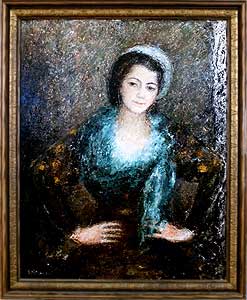Tetes de Montparnasse - By Nesto Jacometti
Translation: Rebecca McKnight, 2006
 |
Cathérine,
Spanish Girl |
The tempest had passed, sweeping its angry winds over the port of New York, and already the biblical meteor was drawing its arch of seven colors across the humid air, announcing peace.
One can imagine the surprise of the peaceful citizens when, exiting the temporary shelters where the squall had stashed them, they saw, forty meters above their noses, a little naked man nestled in the hand of Bartholdi’s corpulent dame. Serious and ridiculous at the same time, legs crossed, and plucking chords on an Italian guitar, he was spouting Dante’s Paradise into the sky.
The whole village ran to the port to see the phenomenal man who, after having swirled in the spiraling, stormy winds and waters, came to rest there, like useless debris, in the out-stretched hand of Miss Liberty, all while chirping a script incomprehensible to them.
He was brought down to earth by the firemen.
The city, believing in miracles, gave him a hero’s welcome. Who was he? From where did he come? A mystery! The tempest had brought him.
He spoke only Latin and the poetic idiom of Florence. His “dolce conversare” was adorned with a lyric flourish.
But Americans are a practical people. They dressed him as a man of the twentieth century and taught him to speak English, and gave him a voter’s registration card with the name Ary Stillman, meaning “tranquil lion-man.”
Not only was he a tranquil man, but also he had piqued the public curiosity to the point where they gave him the first name of “Lion.”
It was this way and always this way that Ary Stillman went down the street, and inspired by his crazy love of adventure, took long trips across seas, plains, and mountains.
He hid his myopic eyes behind green lenses so that the world would appear all the merrier. At every turn, he trembled with emotion and joy.
From the pavestones of the crossroads to the mysterious closed doors of houses, under the dim yellow hue of the gas street lights, he struck up his sentimental troubadour’s song, accompanied always by the strum of his old guitar.
One moonlit night in Berlin, he was picked up at the Brandenburg Gate by a couple of portly cops who, deaf to his Italian charm threw him in the clink for two weeks.
This sad misunderstanding wrote the epilogue on his career as a troubadour. But he had circled the terrestrial ball enough to fully comprehend the place and era of upheaval where he had finally come to live. Henceforth he understood that the songs of the good old days no longer captivated the hearts of modern man.
By listening to his inner artist’s voice, yet faithful to the spirit of his youth, he ceased singing and found other ways to share the organic rhythms of his poetry.
With the guitar as palette and the chords and strings intertwined and crushed at the tips to form a brush, he began to paint, from sun-up to sundown. His work recalls the ancient motifs, and the faces in his portraits evoke the peaceful humanity that he had admired in the work of Titian or in that of his friend, Ghirlandaio.
Stillman proved himself to be a fine artist, an intelligent observer, and a skilled colorist.
His work is imbued with tranquility, peacefulness and musicality.
He studied in-depth, profoundly observing the masterpieces of the Renaissance from which he had drawn the melodious inspiration for his art.
The faces of his women (he had a lovely collection of them, the lucky devil!) have the same noble and serene expression as the Madonnas of Siena.
Throughout, his work radiates a wonderful sense of nostalgia, a certain familiar mysticism.
…Delightful poses of gorgeous blonds or brunettes with eyes softened by dreams…
…Charming countenances portrayed in hazy yet polychromatic shadows…
Stillman’s landscapes tremble in the faded light of impressionist colors, and his interiors are bathed in a welcoming harmonic light.
The work of Ary Stillman represents the instinctive outpouring of a lyric temperament, vibrating with devotion, inclined toward the quest for the ideal beauty.
He aimed to infuse traditional Latin motifs with simplicity. Sometimes he seems to go off to realms of daring visions but is called back by an inner voice.
So he returns to his old ballads, and he paints in sober tones, faithful to the transcendent rule of his own heart.
A true musician of color, he knows that an illegitimate note or the wrong key could ring false and drive a full and harmonious symphony into oblivion.
Sensitivity and apprehension are married in the work of Stillman, and there, form a happy union where radiant figures seem to take flight in a triumph of joy.
This young painter, simple and modest, raised on great culture and strongly tied to a powerful artistic tradition, cuts his own path, without haste or apprehension, confident in his own style and strengths.
His feverish gaze penetrates the radiant line of the ardent horizon.
And there, where the resounding call of beaming light still vibrates, a vision of a Madonna from Siena or perhaps a shepherdess of Ghirlandaio rises up to smile at him with an old, familiar gaze.
